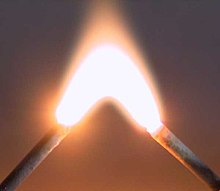
An arc flash is the light and heat produced as part of an arc fault (sometimes referred to as an electrical flashover), a type of electrical explosion or discharge that results from a connection through air to ground or another voltage phase in an electrical system.
Arc flash is distinctly different from the arc blast, which is the supersonic shockwave produced when the uncontrolled arc vaporizes the metal conductors. Both are part of the same arc fault, and are often referred to as simply an arc flash, but from a safety standpoint they are often treated separately. For example, personal protective equipment (PPE) can be used to effectively shield a worker from the radiation of an arc flash, but that same PPE may likely be ineffective against the flying objects, molten metal, and violent concussion that the arc blast can produce. (For example, category-4 arc-flash protection, similar to a bomb suit, is unlikely to protect a person from the concussion of a very large blast, although it may prevent the worker from being vaporized by the intense light of the flash.) For this reason, other safety precautions are usually taken in addition to wearing PPE, helping to prevent injury.[1] However, the phenomenon of the arc blast is sometimes used to extinguish the electric arc by some types of self-blast–chamber circuit breakers.
- ^ Safe Work Practices for the Electrician by Ray A. Jones, Jane G. Jones -- Jones and Bartlett Publishing 2009 Page 40
